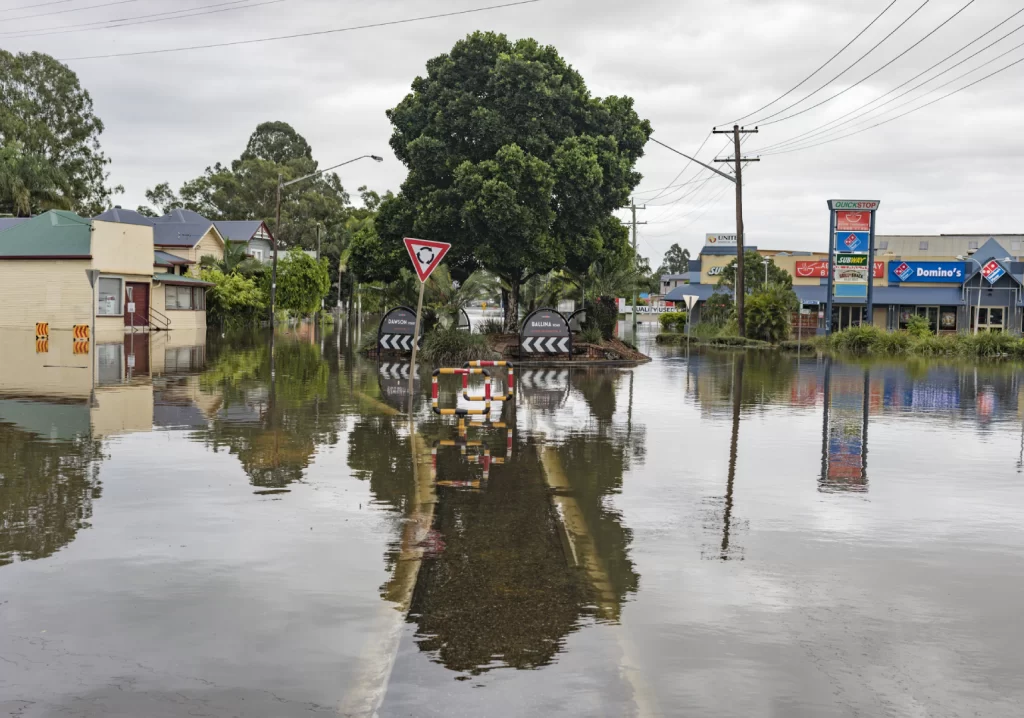A water treatment innovation designed for a flood clean-up effort could be the answer for removing forever chemicals before they permeate the environment.
In February 2022, the Northern Rivers town of Lismore was decimated by the biggest flood the region had ever encountered.
Unprecedented rainfall and floods in excess of the one-in-100 average recurrence interval (ARI) had a significant impact on civil infrastructure, explained local engineer James Foster, Director of environmental consultancy ENV Solutions.
“A lot of Lismore’s infrastructure was designed on that one-in-100 year flood,” he said. “All of those designs were inundated by 1.82 m of water.”
This included all of the city’s electrical systems along with businesses that had set up flood-free zones. The water levels were so high that even houses built above the ARI were still impacted.
“Anyone who put their equipment above that level still lost it,” Foster added.
The February flood killed five people and destroyed most of the town’s businesses along with 4000 homes – with the town rocked by another flood one month later.
Once the flood waters receded, the clean-up effort began — including treating a range of highly contaminated water stagnating around town.
“Everything from hydrocarbons to bitumens and service station tanks floated out of the ground,” he said. “Massive wastewater systems were also moved.”
The town’s brand-new landfill cell was another inundated system — filled to the brim with two m of water, which quickly transformed into leachate.
Landfills built in floodplains are protected by levee banks and an impervious liner designed to keep floodwaters out. But these protection mechanisms were not prepared for the mighty floods, with water flowing straight over the top of the banks.
“We had 25 Ml of water mixed with rubbish sitting stagnant in a massive pool, full of nutrients, hydrocarbons, polyfluorinated substances (PFAS) and heavy metals,” Foster said.
The amount of water in the landfill precluded any conventional treatment, with the municipal wastewater system that usually manages the town’s leachate also destroyed.
The only viable option was trucking 25 Ml of water out at a cost of 40 c/kL, until ENV was engaged by Public Works to come up with an environmentally sound solution that wouldn’t break the bank. Here’s how they did it at a cost of four cents per kilalitre, winning the Engineers Australia Project of the Year Excellence Award in the Newcastle Division.
Combining processes
ENV Biological Leachate Remediation (BLR) solution is a combination of established physical, biological, polishing and disinfection water treatment stages rolled into one novel solution.
“We used algae to do the heavy lifting and nutrient removal, making use of an existing leachate treatment pond to get those algae to grow,” Foster said.
First things first, the ENV team experimented to find an algal species that would work best.
“We did a number of studies of algal species,” he said. “Depending on the climatic conditions and the conditions in the pond, we changed algal species as we learned how to turbocharge their growth cycle.”
The aim was to make the conditions as comfortable as possible for the algae by batch-filling the treatment pond with water, so they could chomp on the nutrients that needed to be removed.
“They love eating nutrients, especially ammonia nitrogen,” Foster said. “We also dropped out all the suspended solids, made sure the pH was right, then added some special herbs and spices.” After we gave them the right ratio of foods, they flourished.”
The BLR process generated an algae concentration 30 times what the ENV team started with.
Once all the nutrients were removed, a polishing step filtered out any residual solids — including PFAS.
“We used a special media which binded onto any PFAS, hydrocarbons or heavy metals and removed them,” Foster said.
The project commenced in May 2022, running in two tranches.
“We’d fill up a five Ml pond, treat it, settle it out, then dispose of it,” Foster said. “Then we were supported by Public Works to up our game and run a continuous treatment process in a massive big pond of algae.”
By September, the whole landfill cell had been emptied, allowing the new infrastructure to be restored for use.
Removing forever chemicals
PFAS, an emerging contaminant of concern for many local councils, is in very low concentrations throughout the nation’s landfills.
“Certain plastics, glass, fry pans, raincoats, fabric softeners and sunscreen all have very low levels of PFAS,” Foster said. “But it is getting into our leachate, and it is becoming an issue across the board.”
When this leachate is sent to traditional municipal wastewater treatment plants, there is nothing to stop PFAS from going straight into the receiving environment, following a dilution process transforming it into biosolids.
“Bacteria chomp on all the nutrients, absorbing some of the PFAS which ends up in biosolids,” he said. “Traditionally one of the beneficial reuse methodologies for biosolids has been applying them onto their farmland.”
Through the BLR treatment process, PFAS is removed from leachate at the source.
“Irrespective of whether we supply treated water to a wastewater treatment plant or back to the receiving environment, we’ve basically put a stop to PFAS spreading out there,” Foster said.
While the BLR process was a temporary solution for an emergency situation, ENV has piqued the interest of a number of councils around New South Wales that have similar issues with PFAS in leachate.
“We’re working with the Environmental Protection Agency and some of these councils to determine whether the BLR solution is right for them,” Foster said.
“We gained a huge amount of knowledge throughout the process, which we can potentially commercialise and use to help others.”
The national Excellence Awards are to be announced in Melbourne on 29 November. Register for the Gala event here.
